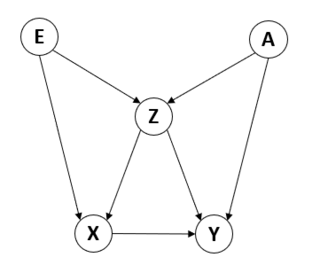后门准则
为何需要后门准则
在结构因果图中,我们往往需要估计变量[math]\displaystyle{ X }[/math]对另一个变量[math]\displaystyle{ Y }[/math]的因果效应,而结构因果图也随着图中节点数量的增加变得异常复杂,进一步加大了因果效应估计的难度。在计算[math]\displaystyle{ X }[/math]对[math]\displaystyle{ Y }[/math]的因果效应时,我们必须保证排除一切存在与变量[math]\displaystyle{ X }[/math]与[math]\displaystyle{ Y }[/math]之间的虚假关系,即非[math]\displaystyle{ X }[/math]对[math]\displaystyle{ Y }[/math]的因果途径,同时保持变量[math]\displaystyle{ X }[/math]与[math]\displaystyle{ Y }[/math]的因果途径完好无缺。而后门准则就是用于快速排除一切非因果途径的有效判断准则, 是结构因果图在实际应用中使用最广泛的基础准则之一。
后门准则定义
给定有向无环图中的一对有序变量[math]\displaystyle{ (X,Y) }[/math],如果变量集合[math]\displaystyle{ \mathbf{Z} }[/math]满足:
- [math]\displaystyle{ \mathbf{Z} }[/math]中没有[math]\displaystyle{ X }[/math]的后代节点;
- [math]\displaystyle{ \mathbf{Z} }[/math]阻断了[math]\displaystyle{ X }[/math]与[math]\displaystyle{ Y }[/math]之间的每条[math]\displaystyle{ X }[/math]的后门路径,则称[math]\displaystyle{ \mathbf{Z} }[/math]满足关于[math]\displaystyle{ (X,Y) }[/math]的后门准则。
注意:有序变量[math]\displaystyle{ (X,Y) }[/math]的后门路径指在变量[math]\displaystyle{ X }[/math]和[math]\displaystyle{ Y }[/math]之间的任何指向[math]\displaystyle{ X }[/math]的路径。
如果变量集合[math]\displaystyle{ \mathbf{Z} }[/math]满足[math]\displaystyle{ (X,Y) }[/math]的后门准则,那么[math]\displaystyle{ X }[/math]对[math]\displaystyle{ Y }[/math]的因果效应可以对变量集[math]\displaystyle{ \mathbf{Z} }[/math]的校正得到,即对[math]\displaystyle{ \mathbf{Z} }[/math]进行求和,具体表现如下:
[math]\displaystyle{ P(Y=y|do(X=x)) = \sum_zP(Y=y|X=x, \mathbf{Z}=z)P(\mathbf{Z}=z) }[/math]
后门准则背后逻辑
当试图寻找变量集合[math]\displaystyle{ \mathbf{Z} }[/math]来估计[math]\displaystyle{ X }[/math]对[math]\displaystyle{ Y }[/math]的因果效应时,寻找一个条件节点集合[math]\displaystyle{ \mathbf{Z} }[/math]使得能阻断任何含有指向[math]\displaystyle{ X }[/math]的后门路径(指可能使得[math]\displaystyle{ X }[/math]和[math]\displaystyle{ Y }[/math]相关但并不传递X产生的因果效应),因为如果不阻断这些后门路径,它们会混淆[math]\displaystyle{ X }[/math]对[math]\displaystyle{ Y }[/math]的因果效应。后门准则包含两个方面的路径检查:
- 阻断任何变量[math]\displaystyle{ X }[/math]到变量[math]\displaystyle{ Y }[/math]的后门路径/伪路径(伪路径是指不同于从变量[math]\displaystyle{ X }[/math]指向变量[math]\displaystyle{ Y }[/math]有向路径的所有其他路径);
- 确保现在所有从变量[math]\displaystyle{ X }[/math]到变量[math]\displaystyle{ Y }[/math]的路径不变。
第一个检查是为了确保条件节点集合不能包含变量[math]\displaystyle{ X }[/math]的后代节点,因为在进行评估[math]\displaystyle{ X }[/math]对变量[math]\displaystyle{ Y }[/math]的因果效应时,会对变量[math]\displaystyle{ X }[/math]采取干预,继而影响变量[math]\displaystyle{ X }[/math]的后代节点,从而影响变量[math]\displaystyle{ Y }[/math],但以[math]\displaystyle{ X }[/math]的后代节点为条件会阻断这些路径。
第二个检查是为了阻断所有一切伪路径以及条件节点集合引入的新伪路径。
后门准则实例
实例1
在图1的因果图中包含四个变量[math]\displaystyle{ X }[/math]、[math]\displaystyle{ Y }[/math]、[math]\displaystyle{ W }[/math]、[math]\displaystyle{ Z }[/math]四个变量,现在我们估计变量[math]\displaystyle{ X }[/math]对变量[math]\displaystyle{ Y }[/math]的因果效应,即搜索满足有向变量对[math]\displaystyle{ (X,Y) }[/math]的后门准则的变量集合。不难发现,节点[math]\displaystyle{ W }[/math](非[math]\displaystyle{ X }[/math]的后代)阻断了指向[math]\displaystyle{ X }[/math]的后门路径[math]\displaystyle{ X\leftarrow Z \rightarrow W \rightarrow Y }[/math],但没有创造新的后门路径或者改变从[math]\displaystyle{ X }[/math]到变量[math]\displaystyle{ Y }[/math]的有向路径,因此单个节点[math]\displaystyle{ W }[/math]满足后门准则,因此,只要校正[math]\displaystyle{ W }[/math]就能得到从变量[math]\displaystyle{ X }[/math]到变量[math]\displaystyle{ Y }[/math]的因果效应,即
[math]\displaystyle{ P(Y=y|do(X=x)) = \sum_wP(Y=y|X=x, W=w)P(W=w) }[/math]
实例2
在寻找满足后门准则的节点集合时,需要特别关注对撞节点。
在图2中,当节点集合为空集时,没有存在从[math]\displaystyle{ Y }[/math]到[math]\displaystyle{ X }[/math]的伪路径。但是,如果节点集合中包含对撞节点[math]\displaystyle{ W }[/math],则打开了路径[math]\displaystyle{ X\rightarrow W \leftarrow Z\leftarrow T\rightarrow Y }[/math],该路径不是从[math]\displaystyle{ X }[/math]到[math]\displaystyle{ Y }[/math]的因果路径,因此是伪路径,打开这条路径会产生偏差并导致错误的答案。这也意味着,对[math]\displaystyle{ W }[/math]的每个值分别计算[math]\displaystyle{ X }[/math]和[math]\displaystyle{ Y }[/math]的关联性,不会得到[math]\displaystyle{ X }[/math]对[math]\displaystyle{ Y }[/math]的因果效应,甚至对于[math]\displaystyle{ W }[/math]的每个值计算[math]\displaystyle{ X }[/math]和[math]\displaystyle{ Y }[/math]的关联性也是错误的。
那么,当指定[math]\displaystyle{ W }[/math]为一个确定值[math]\displaystyle{ w }[/math]时,如何计算[math]\displaystyle{ X }[/math]对[math]\displaystyle{ Y }[/math]的因果效应?解决方法是选择其他变量来阻断由[math]\displaystyle{ W }[/math]打开的路径。例如,选择变量[math]\displaystyle{ T }[/math]为条件,仍可阻断[math]\displaystyle{ X\rightarrow W \leftarrow Z\leftarrow T\rightarrow Y }[/math],因此,为了计算[math]\displaystyle{ w }[/math]-特定因果效应[math]\displaystyle{ P(y|do(x),w) }[/math],可以对变量[math]\displaystyle{ T }[/math]进行校正:
[math]\displaystyle{ P(Y=y|do(X=x), W=w) = \sum_tP(Y=y|X=x, W=w,T=t)P(T=t|X=x, W=w) }[/math]
[math]\displaystyle{ w }[/math]-特定因果效应[math]\displaystyle{ P(y|do(x),w) }[/math]表明[math]\displaystyle{ X }[/math]对[math]\displaystyle{ Y }[/math]的因果效应依据[math]\displaystyle{ W }[/math]值的变化而改变。
实例3
在某些因果图中,校正对撞节点有时候是不可避免的,如图3所示。
在图3中,从[math]\displaystyle{ X }[/math]到[math]\displaystyle{ Y }[/math]有四条后门路径,而且都经过[math]\displaystyle{ Z }[/math]节点,其中[math]\displaystyle{ Z }[/math]节点在路径[math]\displaystyle{ X\leftarrow E \rightarrow Z \leftarrow A \rightarrow Y }[/math]中是一个对撞节点,以[math]\displaystyle{ Z }[/math]为条件会导致这条路径联通。因此,要阻断所有后门路径,可以选择包含变量[math]\displaystyle{ Z }[/math]的变量集合,[math]\displaystyle{ \{Z,A \} }[/math]、[math]\displaystyle{ \{Z,E \} }[/math]、[math]\displaystyle{ \{Z,A,E \} }[/math]。


